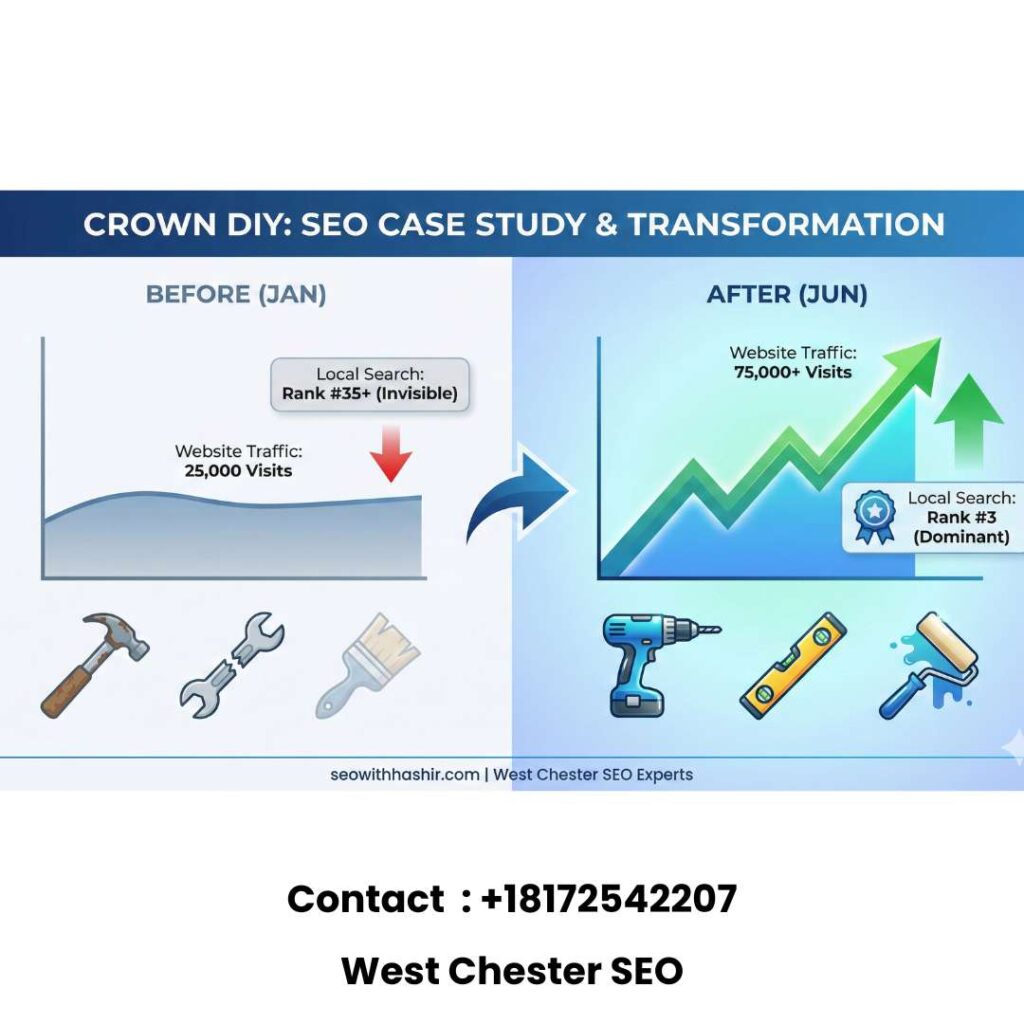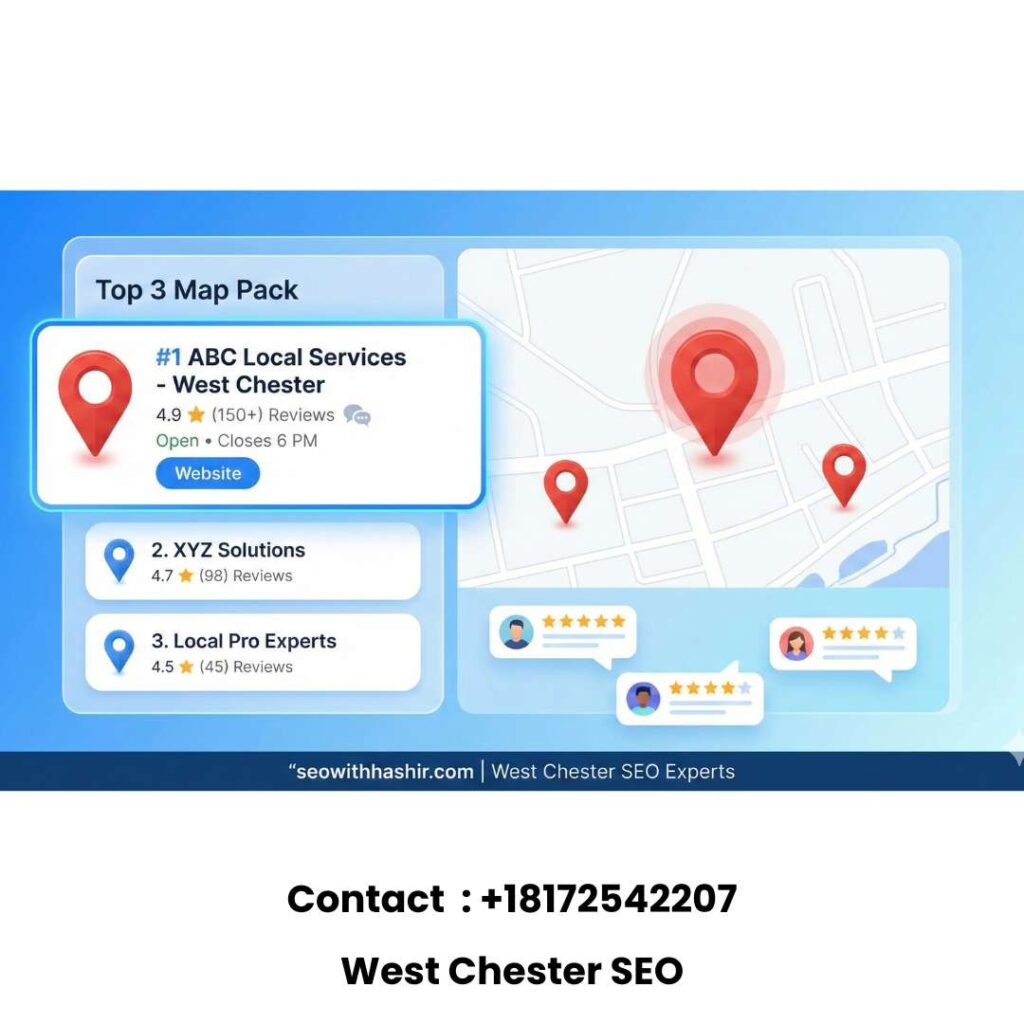West Chester SEO Expert That Will Help You Get More Leads and Revenue Through SEO
Expert SEO strategies built to grow your local visibility, attract qualified traffic, and increase monthly leads.
Get a Free SEO QuoteWhy Choose Hashir as Your Wester Chester SEO Expert?
With years of dedicated experience in search engine optimization, I deliver measurable SEO results through transparent processes and ROI-focused strategies. My approach combines technical expertise with local market knowledge to drive sustainable growth for your West Chester business.
Contact on WhatsappAffordable, High-Impact SEO
Get high-performing SEO strategies designed around your budget — focused on sustainable, trackable growth.
No Long Term Contracts
Stay for results, not obligations. You’re free to continue only if you love the progress.
Complete Transparency
Every step is clear you’ll receive performance reports and live rank tracking every month.
\Real SEO Results That Prove What We Deliver
Businesses across the United Kingdom trust Hashir’s data driven SEO approach to grow traffic, calls, and revenue. Here are some success stories that show our proven results.
Crown DIY
Stronghold Doors
Prime Garage Solutions
Our Chester SEO Services Include:
We provide complete SEO solutions designed to help Chester businesses dominate their local search rankings and outperform competitors.
Contact meLocal SEO Optimization
Dominate local search results and Google Maps for Chester-based customers.
On-Page SEO & Content Strategy
Optimize your website content and structure for better search visibility.
Technical SEO Audits
Identify and fix technical issues that hurt your search rankings.
Link Building & Authority Growth
Build quality backlinks to establish your website as an authority.
Google Business Profile Optimization
Maximize your Google Business Profile to attract more local customers.
Conversion Rate Optimization
Turn more website visitors into paying customers.
SEO Reporting & Analytics
Track performance with detailed monthly reports and insights.
Frequently Asked Questions
Most clients begin seeing initial improvements within 4-8 weeks, with significant traction typically occurring between 3-6 months. The timeline varies based on your industry competition, current website health, and the consistency of our optimization efforts.
No long-term contracts are required. I work on a month-to-month basis so you can pause or stop services at any time. I believe in earning your business through results, not binding contracts.
My approach combines deep local knowledge of the West Chester market with transparent, data-driven strategies. You work directly with me (Hashir), not junior account managers, ensuring expert attention and customized strategies tailored to your specific business goals.
Absolutely! Google Business Profile optimization is a core part of my local SEO services. I’ll optimize your listing, manage reviews, add relevant photos, and implement strategies to improve your local map pack visibility for Chester-based searches.
Let’s grow your West Chester business with SEO strategies that deliver real, lasting results.
Stop missing out on valuable leads and start dominating search results today.
Get Your Free SEO Quote Now
The West Chester SEO Expert That Drives Leads & Revenue
You have built a business in West Chester. You offer a great service. You treat your customers well. But there is a problem. Your phone is not ringing as often as it should. You look at your competitors in Chester County, and they are everywhere. They show up at the top of Google Maps. They appear first when you search for services on your iPhone. It is frustrating. You know you are better than them, yet they are getting the calls.
This is not because they are better at the job. It is because they have mastered Search Engine Optimization (SEO).
I am here to fix that for you. My name is Hashir, and I am a West Chester SEO Expert. I do not believe in magic tricks. I believe in data, hard work, and strategies that actually bring customers to your door. When you search for “Affordable Local SEO Services near me,” you find many agencies promising the moon. They use fancy words and send you automated reports that make no sense.
I do things differently. I treat your business like it is my own. I understand that ranking on Google is not just about vanity metrics. It is about feeding your family. It is about paying your employees. It is about growing your brand in West Chester, PA.
If you are tired of being invisible online, you are in the right place. Let us turn your website into a lead-generating machine.
You Might Like : Professional Web Design West Chester PA
Top Rated SEO Company in West Chester, PA | SEO With Hashir
I have spent years analyzing how search engines work. Google changes its rules constantly. What worked in 2020 does not work today. If you are using outdated tactics, you are actually hurting your website. I have seen business owners try to do this themselves. They read a few blogs and try to stuff keywords into their text. Then they wonder why their traffic drops.
It is like trying to fix a modern car engine with a hammer. You might hit something, but you will likely break more than you fix.
At SEO With Hashir , I focus on what matters. I focus on “High Intent” keywords. These are the words people type when they are ready to buy right now. For example, someone searching for “how to fix a leaky pipe” is looking for advice. Someone searching for “emergency plumber West Chester PA” has a credit card in their hand. I target the second person for you.
My approach is personal. When you work with big agencies, you are just a number. You get passed around to junior account managers who have never ranked a site in their life. When you work with me, you get me. You get an expert who knows the local market in Pennsylvania. You get someone who understands the difference between a customer in West Chester Borough and a customer in Exton or Malvern.
Why Choose Hashir as Your West Chester SEO Expert?

You might be asking, “Why should I trust you?” That is a fair question. The SEO industry is full of snake oil salesmen. I have heard the horror stories. I have spoken to business owners who paid thousands of dollars a month for zero results. It makes me angry. It gives my industry a bad name.
Here is why I am different.
Affordable, High Impact SEO Strategies
SEO should not bankrupt you. I believe in affordable SEO packages that deliver a return on investment. You should not have to choose between paying for marketing and paying your rent. I tailor my strategies to your budget. We start with the actions that bring the quickest wins. As you make money, we can scale up.
No Long-Term Contracts – Just Results
Most agencies want to lock you into a 12-month contract. They do this because they know it takes months to see they are not doing anything. I do not do that. I work on a month-to-month basis. I believe I have to earn your business every single month. If I am not delivering value, you should be free to leave. This keeps me sharp. It ensures I am always pushing for better rankings for your West Chester business.
Complete Transparency & Monthly Reporting
You will never have to guess what I am doing. I provide clear, simple video reports. I do not just send a PDF full of graphs. I record a video walking you through the data. I show you exactly where your traffic is coming from. I show you which keywords are moving up. I explain what I did last month and what I plan to do next month. You deserve to know where your money is going.
Our Comprehensive West Chester SEO Services Include:
I do not offer a “one size fits all” package. Your business is unique. A lawyer needs a different strategy than a pizza shop. However, there are core pillars of SEO that every website needs to succeed in West Chester.
Local SEO Optimization for Chester County
This is the bread and butter for local businesses. You need to show up when people search for services in West Chester, Downingtown, Exton, and surrounding areas. I optimize your online presence so you dominate the local map results. I ensure your Name, Address, and Phone number (NAP) are consistent across the entire internet. This builds trust with Google.

On-Page SEO & Content Marketing Strategy
This is about what is on your website. I optimize your headlines, your text, and your images. But it is not just about keywords. It is about being helpful. I write content that answers your customers’ questions. If you are a plumber, I will write about “Why your water heater is making noise.” This positions you as the authority. When people trust your content, they hire your company.
Technical SEO Audits & Site Health Checks
Think of your website like a car. It might look shiny on the outside, but if the engine is broken, it will not run. Technical SEO fixes the engine. I look for broken links. I fix 404 errors. I create a roadmap for Google’s “spiders” to crawl your site easily. If Google cannot read your site, it cannot rank your site.
Link Building & Domain Authority Growth
Links are like votes. When another website links to yours, it tells Google, “This website is trustworthy.” But not all votes are equal. A link from a local university or a major newspaper is worth gold. A link from a spammy directory is worthless. I have a strategy to earn high-quality, safe backlinks that boost your authority.
Google Business Profile (Map Pack) Optimization
Your Google Business Profile is your new homepage. Many customers will find you on Maps and call you without ever visiting your website. I optimize every inch of this profile. I help you get more reviews. I post updates. I upload geotagged photos. This signals to Google that you are an active, real business in West Chester.
Conversion Rate Optimization (Turn Traffic into Leads)
Traffic is useless if it does not convert. I analyze how people use your site. Are the “Call Now” buttons easy to find? Is the contact form too long? I make small tweaks that lead to big jumps in phone calls. I want your website to work as hard as you do.
Advanced SEO Reporting & Analytics
I do not hide data. I set up Google Analytics and Search Console properly. I track phone calls. I track form submissions. You will know exactly how much revenue my SEO services are generating for you.
West Chester SEO That Builds Trust and Delivers Leads (No Paid Ads Needed)
Paid ads are like a drug. You get a quick hit of traffic, but the moment you stop paying, the traffic disappears. Also, the price of ads keeps going up. It is a bidding war.
Organic SEO is different. It is like planting a tree. It takes a little time to grow, but once it is big, it provides shade for years.
When you rank organically at the top of Google, customers trust you more. They know that anyone can pay for an ad. But they know that Google only ranks the best businesses at the top of the organic results. By investing in West Chester SEO, you are building a digital asset. You are owning your real estate on the internet instead of renting it from Google Ads.
Why Partner with Hashir – The Trusted SEO Company in West Chester PA
There are hundreds of SEO agencies. Why me?
Cost-Effective SEO Solutions for PA Businesses
I keep my overhead low. I do not have a fancy office with a ping-pong table and a barista. I work from my home office. This means I do not have to charge you inflated fees to pay for unnecessary luxuries. You are paying for my expertise, not my office rent.
Leads That Matter: Quality Over Quantity
I do not care about getting you 10,000 visitors if none of them buy. I would rather get you 100 visitors who all need your service today. I focus on “commercial intent” keywords. I filter out the tire-kickers and bring you the buyers.
Work Directly with SEO Expert Hashir (No Middlemen)
When you call, I answer. When you email, I reply. You are not separated from the work by a wall of customer service reps. We are partners in this. I take your success personally.
Proven Success with Local Service Businesses
I understand the nuances of service businesses. I know that if you are a roofer, you need leads when it rains. I know that if you are an HVAC tech, you need leads when the heat wave hits. I adjust our strategy based on seasonality and local demand.
What Is Local SEO for West Chester Businesses?
Local SEO is a specific type of search engine optimization. It focuses on optimizing a website to be found in local search results.
Here is an example. If you search for “best pizza,” Google will not show you a pizza shop in New York if you are in West Chester. It uses your location to show you results “near me.”
For a business in West Chester, this is critical. You are competing for a small geographic area. You need to signal to Google that you are the most relevant result for people in zip codes like 19380, 19381, 19382, and 19383.
This involves specific tactics like:
- Optimizing for “Near Me” searches.
- Building local citations (listings in local directories).
- Getting reviews from local customers.
- Creating content about local events or news.
Real SEO Results: Case Studies That Prove We Deliver
Anyone can claim they are an expert. I prefer to let the results speak for themselves. I have worked with businesses just like yours. I have taken websites from the digital graveyard to the top of page one. Here are a few examples of what is possible when you have the right strategy.
Case Study: Crown DIY
Crown DIY was struggling to get visibility. They had excellent products, but their website was a mess technically. Google could not understand what they were selling. It was like having a store with no sign on the door.

The Challenge:
They were ranking on page four or five for their main products. Nobody looks at page five. It is a ghost town.
The Solution:
I conducted a deep technical audit. I fixed their site structure. I optimized their product descriptions with natural language. I built high-quality backlinks from relevant industry sites.
The Result:
Within six months, organic traffic increased by over 300%. Sales followed suit. They are now dominating their niche.
Case Study: Stronghold Doors
This was a classic local service business case. Stronghold Doors offers garage door repairs and installations. They operate in a competitive area.

The Challenge:
They were relying entirely on paid ads. The moment they stopped paying for ads, the phone stopped ringing. They had zero organic presence in their local service areas.
The Solution:
I created location-specific pages for every town they served. I optimized their Google Business Profile. I helped them generate authentic customer reviews.
The Result:
They now rank in the “Map Pack” (the top 3 map results) for “Garage Door Repair” in their main city. They reduced their ad spend by 50% while getting more leads.
Why SEO Matters for Growth in West Chester, PA
West Chester is growing. The population is increasing. New businesses are opening every month. The competition is getting tougher.
In the old days, you could put an ad in the Yellow Pages. Today, 97% of people look online to find a local business. If you are not there, you do not exist to them.
SEO levels the playing field. A small family-owned business can outrank a giant national corporation if their SEO is better. It allows you to compete with the big guys without having their massive marketing budget. It is the most democratic form of marketing there is.

How Local SEO Helps You Beat Competitors in Chester County
Your competitors are likely making mistakes. I can spot them.
Maybe they have not optimized their images. Maybe their site is slow. Maybe they have ignored their Google Business Profile.

I use advanced spy tools to see exactly what they are doing. I look at their backlinks. I look at their keywords. Then, I build a strategy to beat them. I do not just want to match them. I want to crush them. I want to push them down to page two so that you capture the lion’s share of the market.
SEO Company West Chester PA – Local Experts You Can Trust
Trust is hard to earn and easy to lose. I have seen SEO companies use “Black Hat” tactics. These are tricks that violate Google’s rules. They might buy thousands of fake links or hide text on a page.
This might work for a week. But eventually, Google catches you. And when they do, they punish you. They can ban your website completely.
I only use “White Hat” SEO. These are ethical strategies that follow Google’s guidelines. It takes a bit more work, but it is safe. It builds a foundation that will last for years. You never have to worry about waking up to a penalty.
Search Trends: How Customers Find West Chester Businesses in 2025
The way people search is changing. It is not just typing “plumber West Chester” into a desktop computer anymore.
Lower Cost Per Lead with Targeted Organic Search
Paid ads are getting more expensive every year. The “Cost Per Click” is skyrocketing. With organic SEO, your cost per lead actually goes down over time. Once you are ranking, the traffic is free. You do not pay every time someone clicks. This makes your marketing budget go much further.
Our Simple 3-Step SEO Process for West Chester Clients
I like to keep things simple. We do not need to overcomplicate the process.
Step 1: Website Audit & Competitor Strategy
First, I lift up the hood. I look at everything on your site. I identify every error, every missing tag, and every missed opportunity. I also analyze your top three competitors. I find out why they are winning and make a plan to overtake them.
Step 2: Implementation that Drives Local Growth
This is the work phase. I fix the technical issues. I rewrite the content. I optimize the Google Business Profile. I start building links. This is where the heavy lifting happens. I ensure your website is communicating clearly with Google.
Step 3: Consistent Leads & Campaign Scaling
Once the foundation is set, we watch the data. We see what is working best and we double down on it. If a specific service page is bringing in lots of leads, we create more content around that topic. We expand your reach to neighboring towns. We keep pushing until you are the dominant player in your niche.
How Web Design and Content Impact West Chester Rankings
You cannot separate web design from SEO. They are two sides of the same coin.
I have seen beautiful websites that are invisible to Google because they were built using the wrong code. I have also seen ugly websites that rank well but nobody calls because they look unprofessional.
You need the sweet spot. You need a website that is coded cleanly for Google but designed beautifully for humans.

The content must be engaging. It must speak to the customer’s pain. If you sell security systems, do not just list the technical specs of the cameras. Talk about the peace of mind of knowing your family is safe. Talk about the feeling of security. This emotional connection keeps people on the page longer, which boosts your rankings.
Mastering Local Search Visibility for Maximum Traffic
Visibility is about being everywhere your customer looks. It is not just Google Search. It is Google Maps. It is Apple Maps. It is Bing. It is Yelp.
I ensure your business data is accurate across the entire ecosystem. If Google sees that your address is different on Facebook than it is on your website, it gets confused. It lowers your trust score. I clean up these data inconsistencies. I make sure the internet speaks with one voice about your business.
How to Get Started with West Chester SEO Dominance
You do not need to be a tech wizard. You just need to take the first step.
Build Your Local Business Presence
It starts with claiming your digital territory. We ensure your Google Business Profile is verified. We ensure your website is indexed. We make sure you exist on the digital map.
Target the Right “Near Me” Keywords
I conduct extensive keyword research. I look for the hidden gems. I find the specific phrases people in West Chester use. Maybe they call it “soda” and not “pop.” Maybe they search for “borough” instead of “city.” These local nuances matter. I optimize your content to match the local language.
Optimize for Mobile Users and Voice Search
More than 60% of searches now happen on mobile devices. If your site is not “mobile-friendly,” Google will penalize you. I ensure your site looks perfect on an iPhone, an Android, and a tablet.
Also, voice search is huge. People speak differently than they type. They say, “Hey Siri, find me a good Italian restaurant nearby.” They do not say “Italian restaurant West Chester PA.” I optimize your content to answer these conversational voice queries.
Future-Proofing: AI and Search Changes
Artificial Intelligence is changing search. Google is using AI to provide direct answers. I stay ahead of these trends. I optimize your content to be the “featured snippet” that Google’s AI reads out loud. I ensure your business is ready for the future of search.
The Pillars of Local SEO for West Chester Companies
There are three main pillars we must build.
Google Business Profile & Map Rankings
This is your storefront. It needs to be perfect. I help you get 5-star reviews. I teach you how to respond to reviews (even the bad ones). I ensure your hours are correct. An active, highly-rated profile is the fastest way to get phone calls.
Building Local Citations and 5-Star Reviews
Citations are mentions of your business on other websites. Think of the Chamber of Commerce, Yellow Pages, or Angie’s List. I build these citations manually. I ensure they are accurate.
Reviews are social proof. If you have 4.9 stars and your competitor has 3.2 stars, who gets the call? You do. I implement systems to help you ask for reviews from happy customers automatically.
Creating Location Pages & Schema Markup
If you service West Chester, Exton, and Malvern, you need a page for each. A customer in Malvern wants to see “Plumber in Malvern,” not “Plumber in West Chester.” I create these dedicated pages to cast a wider net.
Schema Markup is a special code language. It tells Google exactly what your content is. It says, “This is a phone number,” “This is a price,” “This is a review.” It helps Google display “Rich Snippets” in the search results, which increases clicks.

On-Page SEO for West Chester Websites – A Complete Guide
On-page SEO is everything within your control on your website.
Keyword Placement & Content Optimization
We do not stuff keywords. We place them strategically. We put them in the main heading (H1). We put them in the first paragraph. We use synonyms. We make it read naturally. The goal is to write for humans first, and search engines second.
Perfecting Title Tags, Meta Descriptions & Interlinking
The Title Tag is the blue link you see in Google. It must be catchy. It must include the keyword. The Meta Description is the short text under the link. It is your ad copy. I write compelling descriptions that make people want to click.
Interlinking is connecting your pages together. I link your “Drain Cleaning” page to your “Emergency Plumbing” page. This keeps users on your site longer and helps Google discover all your content.
Technical Core Web Vitals: Speed, Security & Mobile
Google has a set of metrics called “Core Web Vitals.” They measure speed, responsiveness, and visual stability. I optimize your code to pass these tests with flying colors. I also ensure you have an SSL certificate (the little padlock icon). Google does not trust unsecure sites.
Off-Page SEO Strategies for West Chester Brands
Off-page SEO is your reputation in the wider world.
High-Quality Link Building Strategies
I reach out to bloggers, journalists, and industry partners. I write guest posts. I find broken links on other sites and suggest your content as a replacement. I earn links the hard way because those are the only ones that last.

Reputation Management & Review Generation
Your reputation is your most valuable asset. I monitor what people are saying about you online. If there is a negative review, we address it professionally. We bury the negative with a flood of positive reviews from your satisfied clients.
Content Marketing that Attracts Local Backlinks
I create content that is “link-worthy.” Maybe it is a guide to “Historic Homes in West Chester.” Maybe it is a resource on “Local recycling rules.” Local organizations love to link to this kind of helpful community content. This boosts your authority locally.
Ready to Rank Higher in West Chester, PA?
You have two choices. You can keep doing what you are doing. You can hope that customers will magically find you. You can watch your competitors take the jobs that should be yours.
Or, you can take action. You can decide to dominate your market.
I am ready to help you grow. I have the tools, the experience, and the passion to make your business a household name in West Chester. We will build a strategy that fits your budget and achieves your goals. We will turn your website into your best salesperson.
Do not let another day go by where your phone is silent. Let us change the trajectory of your business.
Book Now for a free consultation. Let us discuss your goals and how we can reach them together.
Frequently Asked Questions About Our SEO Services
1. How long does it take to see results?
SEO is a marathon, not a sprint. Typically, you will start seeing movement in the first 3 months. Significant growth usually happens between months 6 and 12. However, with my local strategy, we often see quick wins in the Map Pack sooner.
2. Do you guarantee a #1 ranking?
No ethical SEO expert can guarantee a #1 ranking. Google controls the algorithm, not me. Be very careful of anyone who promises this. What I do guarantee is that I will improve your visibility, increase your traffic, and deliver high-quality work that follows best practices.
3. Why do I need SEO if I have social media?
Social media is great for brand awareness, but it is “interruption marketing.” People are there to look at photos of cats, not to buy a new roof. SEO captures “intent.” When someone searches on Google, they are actively looking for a solution. The conversion rate is much higher.
4. What is the difference between SEO and PPC (Google Ads)?
PPC (Pay-Per-Click) is renting space. You appear at the top immediately, but you pay for every click. SEO is owning space. It takes longer to get there, but the traffic is free and limitless once you rank. A healthy marketing strategy often uses both, but SEO provides the best long-term ROI.
5. Do I have to sign a long-term contract?
No. I work month-to-month. I believe my results should keep you as a client, not a piece of paper.
6. Will you change my website design?
I might recommend changes if your current design is hurting your rankings (e.g., if it is too slow or not mobile-friendly). However, I will always discuss this with you first. I can work with your existing developer or handle the changes myself.
7. How do we communicate?
I am very accessible. We can communicate via email, phone, or Zoom. You will receive a detailed video report every month, so you always know exactly what is happening.
Contact Hashir SEO today. Let us put your West Chester business on the map.
